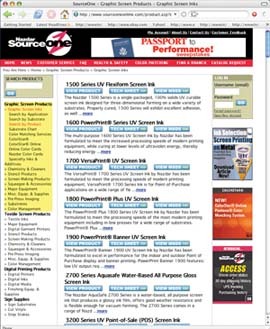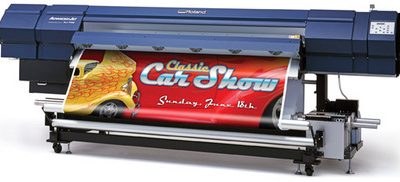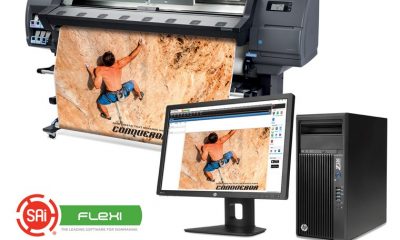Business & Industry
Published
17 years agoon

Buying products online is old hat for most Internet users. Amazon.com has been selling books for more than ten years, and eBay.com, the world-wide yard sale and auction house, has been around almost as long.
Buying products online is old hat for most Internet users. Amazon.com has been selling books for more than ten years, and eBay.com, the world-wide yard sale and auction house, has been around almost as long.
However, in the world of screen printing, selling online is a relatively new trend. Business-to-business commerce has been slower to embrace the technology than retail, but it is catching up fast. Pioneering brick-and-mortar industrial distributors such as Grainger (www.grainger.com) have successfully proven that, even in B2B, if you build an online store, they will come.
The rise of e-commerce in the screen industry
The growing trend toward online sales that retail consumers have experienced in recent years is beginning to show up among manufacturers and distributors serving specialty graphics producers. One example is Nazdar SourceOne, which launched its new e-commerce site, www.sourceoneonline.com, at the end of the first quarter of 2006. The site offers the company’s complete line of products for screen and digital printing, along with downloadable MSDSs and technical-data sheets. Peter Walsh, vice president and general manager for Nazdar SourceOne, says that the response to the site has been overwhelmingly positive.
"What’s happening in e-commerce is affecting all businesses," Walsh says. "Screen printing is adopting this technology like all of business."
Graphic Solutions Group (GSG) in Dallas, TX, has been selling products online for about five years at www.gsginet.com, but an overhaul of the site is in the works to offer more products and information, according to company President Mark Granberry. "It’s another way to market your company, but it’s also not a cheap endeavor to get all of the software systems," he says. "It’s not just that you have to build it. You have to maintain it and keep it fresh."
Granberry notes that many screen-printing-supply distributors initially jumped out on the Internet with Websites that essentially amounted to cyberspace business cards, telling potential customers what phone number to call for a catalog. It took some time for these companies to start selling products online.
That delay allowed the Internet to open the door for newcomers. In just a few years, 25-year-old Ryan Moor has gone from selling a press here and there to running Ryonet Corp., a multi-million-dollar screen-printing-supply company based in Vancouver, WA. The company sells almost exclusively through its Website, www.silkscreeningsupplies.com.
"I basically got into it by selling on e-Bay in 2004 with a few supplies and small presses for beginners," Moor says. "In the beginning it was hard to source products because no manufacturer would work with me. I had to be creative."
He started out with the wooden presses he built to sell for some extra cash while part of a rock band. Soon he set aside the dream of pop stardom and began reselling ink and other products he had purchased from Portland-area distributors. Once his sales numbers had increased, manufacturers began selling to him directly. With established distributors still unsure about the Web, Moor seized his opportunity. His company has about 20 employees and sells products from more than 50 vendors.
"I did some research and saw some screen-printing companies online, so the market wasn’t completely open, but it was a lot more open than it is now," he says. "I thought it would be a good niche to get into, and it’s worked out so far."
Who’s buying online?
Buying online has become especially popular with smaller screen-printing operations. Ryonet targets new screen-printing shops and the small to mid-sized operations that were often forgotten by the brick-and-mortar distributors. These smaller businesses, many of which are hometown T-shirt printers, have long relied on catalogs and trade shows to find out about the latest, while larger shops received regular visits from salespeople.
"You’ve got somewhat of a fragmented industry," Walsh of SourceOne says. "The larger customers are generally assigned account representatives from the major suppliers who call them. They provide on-site tech support. They also provide a two-legged portal to technological development. It’s just not economically feasible for a distributor to send a salesperson out to personally call on the many small shops in their territory—which is a shame because the smaller shops represent a lot of business and many of them grow into major customers."
A Website reaches out to these small and mid-sized companies, and, in some ways, it levels the playing field in an industry where a minority of printers purchase a majority of the supplies. The Internet provides the corner shop making Little League T-shirts with the same information and access to distributors as a company licensed by Major League Baseball.
"The greater number of our customers are medium to small-sized businesses where much of their contact is calling in to talk to customer service or buying from a catalog," Walsh says. "But the best catalog you print is out of date by the time it hits the printing press."
A full-service Website can be a knowledgeable, always up-to-date salesperson for thousands of screen-printing and specialty imaging shops. So SourceOne and other companies leading the online shopping revolution in the screen-printing industry include detailed product descriptions and an abundance of information on their sites.
Granberry at GSG promises a similar depth of information on his company’s forthcoming site. "What we’re really trying to do is put our catalog out there online and make it easy to use with just a point and click," he says. "We haven’t really marketed the ability to order online as aggressively as we want to."
Granberry says the new site will offer improved graphics along with some of the intuitive features, such as product suggestions that state-of-the-art software can provide. He says the improved site should attract smaller companies with its user-friendly interface, but the current site has been used as much by the companies with account representatives as those without. The site eliminates the need for a middleman, freeing up those representatives to do more customer service and less selling.
"It’s actually been more of a benefit to the customers we have already. They’d rather place their order online than talk to somebody," Granberry says. "It’s a little unusual in that a lot of people want to do it that way. It’s really been small and large customers alike—as long as they have the Internet."
What’s the main reason why online ordering has gained popularity so rapidly? Convenience. Both Granberry and Walsh say their customers enjoy making their orders any time, day or night, weekday or weekend. In other words, the Internet lets customers make purchases when it is convenient to them, not when a salesperson is available.
"The online shopping experience allows you to see things more immediately, so you can implement new technology to grow your business without waiting for someone to bring it to you or waiting to go out to a trade show," Walsh says. "You choose the timing and accessibility."
Moor at Ryonet says people sometimes forget to call their distributor. And he points out that his customers in rural areas often don’t have a nearby distribution source.
Granberry says he expects GSG’s new site to take on a larger share of his company’s total sales. Like its current incarnation, the new site will link to the company’s complete inventory, meaning that a customer will be able to see just how much of a product is in stock and can make the order directly. With aggressive marketing, he says he hopes to do five times more business online with the new site, thus justifying the significant investment.
"In the statistics that I’ve seen on going into the future, ideally, it would be nice if 25% of our business were done online," he says. "If it could be more, that would be great. That’s really our goal: to get more of our business done online."
While Granberry says he wants the site to be an informational resource that will result in purchases through the site, Walsh at SourceOne has a slightly different outlook. He says he expects his company’s site to serve first and foremost as a reference for shoppers, not buyers.
"I’m less of a believer that people will do all of their purchasing online. I think they’ll do their shopping online and do their purchasing in person or on the phone," Walsh explains. "We have seen increased traffic, both in increased sales with people buying online and an increase in people using the site as a reference source."
While larger suppliers tend to deal mainly in business-to-business trade, another company has used its Website to reach out to schools and hobbyists. Dick Blick Co. in Highland Park, IL sells art supplies, and, although screen-printing equipment makes up a small portion of its market, the Internet has proven to be a valuable tool to sell it.
"Most of our specialty business is done over the Internet," says Lanny Rosenbaum, vice president of sales and marketing for Dick Blick, which has 32 retail outlets. "Every product we carry is available on the Internet. If you wanted to take the time, you could see 60,000 SKUs on our site."
While high schools make up the lion’s share of the company’s screen-printing sales, the average customer turns to www.dickblick.com, he notes, and the schools are following.
"Most of the orders from schools come through purchase orders, but an increasing number of purchases are done through the Web," Rosenbaum says. "On a consumer basis, a very high percentage come over the net."
On the Dick Blick Website, customers see links advertising "Hot Deals." For the small to mid-sized shops that may not have the means to buy in bulk like their larger competitors, these types of Internet offers could spark a new level of competition.
"As e-commerce becomes more sophisticated, targeting specific customer groups and offering more incentives and special offers will be possible," explains Paul Frankel of Origin, the Evanston, IL-based marketing communications group that designed SourceOne’s site. "As more distributors come online and fight for the same customer dollar, they’re going to have to create more enticements and incentives. However they do it, the competition in the end is going to benefit the printers."
Distributors have long worked within a system that divided North America into regions, giving each company a territory in which to sell. On the Internet, there are no geographical boundaries, so a company in the Southwest may now find itself with customers in the Northeast, if the price is right.
"A smaller shop can get really aggressive pricing without buying a lot of product if you get smart and creative looking online," Moor says. "The Internet has made it possible for a smaller company like myself to become renowned. In the past it would have taken five years to reach the point we have in two years, because we’re not tied to a region. Our region is pretty much the US and Canada."
Cyber shopping is here to stay
For the screen-printing industry, the age of the Internet may have come late, but it is coming on strong with sales channels expanding into Cyberspace while upstart companies make a name for themselves on the World Wide Web. Ryonet’s founder was just a teenager when consumers first heard the promise of the Internet, but he says that the future is now upon us.
"They’ve talked about it for years, but it’s coming to fruition," Moor explains. "The more advanced the Internet gets, the more people look to it for their purchasing."
About the author
Drew Mangione has worked for more than six years writing for newspapers and currently lives in Northern New York. He recently stepped away from the daily grind to pursue his interest in freelance journalism while also focusing on a career as a novelist. He can be reached at drew.mangione@gmail.com.
E-Commerce Sites for Screen Printers, Digital Printers, and Sign Companies
Coast Graphics Supply
www.coastgraphicsupply.com
Desmond Process Supply Co.
www.desmondpro.com
Graphic Solutions Group (online shopping coming soon)
www.gsginet.com
Lawson Screen & Digital Products, Inc.
www.lawsonsp.com
Nazdar SourceOne
www.sourceoneonline.com
Ordway Sign Supply
www.signsupply.com
Printa Systems
www.printa.com
Reich Supply Co., Inc.
www.reichsupply.com
Ryan Screen Supply, Inc.
www.ryanrss.com
Ryonet Corp.
www.silkscreeningsupplies.com
Screen Printing Superstore
www.screenprintingsuperstore.com
Screen Printing Supplies, Inc.
www.sps-i.com
Sign Warehouse
www.signwarehouse.com
Tubelite Company, Inc.
www.tubelite.com

Subscribe

Magazine
Get the most important news
and business ideas from Screenprinting Magazine.
Most Popular
-

 Case Studies2 months ago
Case Studies2 months agoHigh-Density Inks Help Specialty Printing Take Center Stage
-

 Art, Ad, or Alchemy2 months ago
Art, Ad, or Alchemy2 months agoF&I Printing Is Everywhere!
-

 Andy MacDougall2 months ago
Andy MacDougall2 months agoFunctional and Industrial Printing is EVERYWHERE!
-

 Columns3 weeks ago
Columns3 weeks ago8 Marketing Mistakes Not to Make When Promoting Your Screen Printing Services Online
-

 Editor's Note3 weeks ago
Editor's Note3 weeks agoLivin’ the High Life
-

 Marshall Atkinson3 weeks ago
Marshall Atkinson3 weeks agoHow to Create a Winning Culture in Your Screen-Printing Business
-

 Thomas Trimingham2 months ago
Thomas Trimingham2 months ago“Magic” Marketing for Screen Printing Shops
-

 News & Trends2 months ago
News & Trends2 months agoWhat Are ZALPHAS and How Can You Serve Them in Your Print Business?






